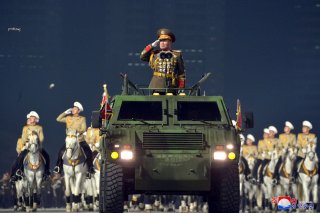Totalitarian Terror: How North Korea Wages War on Seoul
In 1987, two North Korean agents planted a bomb on Korean Air flight 858, killing all 115 aboard. Both agents were subsequently captured. While one managed to commit suicide, the other eventually confessed they had been instructed to perform the bombing to cast a shadow over the 1988 Olympics.
Here’s What You Need to Remember: Hopefully, we have seen the last of sports-event terrorism on the Korean Peninsula.
Given the intense passions and rivalries that sports events are known to inspire, it should surprise no one that they so frequently become theatres on which domestic and international political conflicts are liable to play out—sometimes with explosive consequences.
That was certainly the case on September 14, 1986, when a bomb placed in a trash can exploded in the entry to Gimpo International Airport as it was receiving athletes from around twenty-five countries just five days before the tenth Asian Games. Between 1958 and 2001, Gimpo served as Seoul’s primary international airport.
The blast shattered the terminal’s large glass panes (as you can see in this photo) and killed an airport electrician and a family of four who had just bid goodbye to a departing relative. It injured a further thirty-six persons.
The Asian Games, begun in 1951, have taken place at four-year intervals since and are the world’s second-largest multi-sport event, behind only the Olympics. Seoul had previously been slated to host the sixth Asian Games in 1970 but was forced to cede the role due to threats from North Korea.
Now a significantly more modernized, and gradually democratizing Seoul would have a second shot as a host in 1986. Seoul had its sights on an even more prestigious prize: hosting the 1988 Olympic Games. The same facilities could even be used for both events! But Seoul would have to prove that it could manage its responsibilities hosting a sprawling international sports event smoothly—and that North Korea would not find some way to derail everything.
Fundamentally, Pyongyang refused to see its southern neighbor as a legitimate state and placed enormous symbolic weight on curbing its participation in highly public international sporting events.
Not only was Pyongyang boycotting the 1986 Asian Games, but it also didn’t want anyone else to attend either. Most of North Korea’s Communist-aligned allies in Asia, like Vietnam and Cambodia, complied with the boycott—save for the most important of all, China. That defection stung Pyongyang and amounted to a diplomatic victory for the South.
Pyongyang had just three years earlier come very close to blowing up South Korea’s president during a visit to Rangoon, Burma (Yangon, Myanmar today) in October 1983. Due to an error in timing, a bomb planted in the roof of a sacred mausoleum instead killed twenty-one attendees, including much of the South Korean cabinet
But since then, relations seemingly had begun to improve, with Pyongyang allowing the first-ever reunion between family members separated between the divided Koreas in 1985.
The Gimpo airport itself had a history intertwined with past conflicts in Korea. Built on the western outskirts of Seoul during the Japanese occupation of Korea from 1935-1942, Gimpo was the scene of repeated air battles and aerial bombings in the early weeks of the Korean War as it was air-evacuated by South Korea in June 1950, then captured and used as a base for North Korean piston-engine Yak-7 fighters and Il-10 attack planes. Recaptured in September, it became a major hub for U.S. transport and fighter operations for the remainder of the Korean War, known as Kimpo AFB or K-14.
In 1958, Gimpo was re-designated as an international airport, and rapidly became Seoul’s primary air transit location while older, flood-prone Yeouido airport was demolished.
The attack on Gimpo was held culpable for decreasing international attendance of the Asian Games, with hotels reporting only 94,000 foreign checks ins out of a projected 160,000, resulting in financial difficulties.
However, it didn’t prevent the tenth Asian Games from being generally perceived as a success, paving the way for Seoul’s participation in the 1988 Olympics, which would coincide with its full transition to democratic elections.
Unlike other North Korean terrorist incidents, the agents responsible for the Gimpo bombing have never been caught and the CIA described the bombing as “unsolved” in a 1988 intelligence document.
However, it’s a stretch to say there’s much doubt as to North Korea’s culpability in the attack. The following year, two North Korean agents planted a bomb on Korean Air flight 858, killing all 115 aboard. Both agents were subsequently captured. While one managed to commit suicide, the other eventually confessed they had been instructed to perform the bombing to cast a shadow over the 1988 Olympics.
A lot has changed in the last three decades since. As Gimpo struggled to cope with the mounting volume of international travelers to South Korea, it was eventually replaced by an airport in Incheon for international arrivals, though Gimpo still handles domestic flights.
South Korea and North Korean teams have also played together in multiple sporting events, starting with a joint World Table Tennis team in 1991, and culminating in unified Korean teams in the 2018 Winter Olympics in Pyeongchang, South Korea.
Unfortunately, North Korea has repeatedly rebuffed overtures from South Korea’s president Moon for deeper improvements of relations, while discussions between Washington and Pyongyang appear to be on a negative trajectory. But hopefully, we have seen the last of sports-event terrorism on the Korean Peninsula.
This article is being republished due to reader interest.
Image: Reuters

